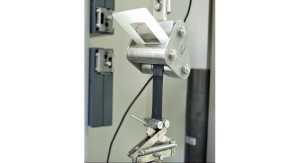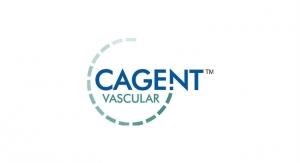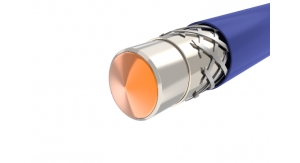Mark Crawford, Contributing Writer10.08.12
Tubing and catheters used in medical devices are growing increasingly sophisticated as medical device OEMs go beyond dimensional requirements to design higher performance into their devices. Higher performance is being driven by specialty compounds, tighter specifications, more lumens with thinner walls between lumens and reinforcement of individual lumens with exotic composites that incorporate a variety of materials such as combinations of polymer fibers and metallic braid elements, polyamide or polytetrafluoroethylene (commonly abbreviated as PTFE). Kink resistance is more prevalent than ever and wire- or filament-reinforced tubes, as well as multiple materials, are being utilized to give better performance.
“An increasing number of customers want smaller tubes that still have the same physical requirements as the bigger tubes they’ve used in the past,” said Robert Kolonia, president of MedConnection, a Phillipsburg, N.J.-based medical device subcontractor that manufactures catheters and other components. “Tighter tolerances with thinner walls are now required for some of these applications.
We have worked on tubing with walls as thin as 0.001 inches and diameters as small as 0.012 inches.”
Tubing continues to get smaller and thinner as minimally invasive surgery continues to drive the need for multi-functionality from tubing.
“In essence, everybody wants smaller and more complex tubing as the number of procedures that utilize minimally invasive techniques and technologies continues to grow,” commented Rudi Gall, managing director for Raumedic, a Leesburg, Va.-based provider of molding, assembly and extrusion services for polymers and silicones. “For example, a single-lumen microbore tube will not be suitable for future medical applications. The tubing must have the same micro-diameter, but also contain multiple lumens to perform tasks such as guidewire access points, fluid-transfer channels, inflation ports or even steering lumens. The challenge is to work with properly dimensioned drawings, whereby the outer diameter and the wall thickness between the lumens are well balanced. When this is properly engineered it’s not a problem to run tubing with up to 13 lumens.”
More complex, multiple-use devices are required to last longer and perform more functions than ever before. A trend toward shorter and smaller-sized tubing is gaining traction, to a point where traditional tubing suppliers cannot or will not supply micro-sized tubing.
“There is also a ‘less is more’ approach to the design of medical devices today,” added Cassie Botti, director of business development for Fluortek Inc., an Easton, Pa.-based custom manufacturer of medical tubing and partially finished medical devices. “Medical device manufacturers are looking for higher-performance devices with fewer components in order to reduce cost and failure modes.”
Combine and Innovate
A growing design challenge for tubing and catheter manufacturers is combining physical properties that normally are contrary to each other to create higher-performance products—such as highly flexible tubing that has good pushability, or kink-resistant tubing that still is highly torquable.
“These combinations affect the way we design tubing and the processes we use to produce tubing,” said Robert LaDuca, CEO for Duke Empirical, a Santa Cruz, Calif.-based medical tubing extruder and manufacturer of catheters, components and devices. “There is an infinite number of design configurations available and by utilizing a long history of experience and capability we can recommend how to achieve the desired performance, which provides a customized solution for the developer's unique application.”
These more complex products often are manufactured using a combination of extrusion technologies—for example, combining micro-extrusion needs with co-extrusion, multi-lumen capability, metal or monofilament braiding and wire inserts. The range of polymers that can be used in tubing extrusion is unlimited—even so, Gall said, most customers “still are interested in those thermoplastics that have been long-established in medical and pharmaceutical applications such as thermoplastic polyurethanes, polyamides, polyolefins, thermoplastic elastomers and plasticized polyvinyl chloride.”
Combining multiple polymer layers to produce tubing of the smallest possible dimensions for medical devices (such as insulin delivery applications or contrast media injection) is a challenge that requires state-of-the-art equipment and precise, real-time monitoring and control. Special micro-extrusion lines can produce multilayer tubing for different applications with up to three different polymer materials.
“With such equipment an inner tube diameter of around 0.004 inches with a wall thickness of around 0.002 inches can be achieved,” Gall said. “These extrusion lines work with extremely small throughput rates, as little as 2 ounces per hour.”
Meeting these dimensions and tolerances is a huge challenge to repeatability and reproducibility. Another complicating factor is the emergence of electronics in medical devices that often require copper or stainless steel wires to be embedded within tubing walls to allow for data transfer. “Metal or filament-reinforced tubing, which requires braiding know-how and capabilities, is also a growing requirement to achieve a high degree of torque (the ability to twist the catheter) for catheter guidance,” Gall added.
Co-extrusion of multiple polymer material also is used to combine an inner layer and outer layer of two different polymer materials—a good example is an epidural catheter used in regional anesthesia. This tubing is inserted via a tiny metal cannula into the nerve channel in the spine. The catheter must be narrow enough and flexible enough not to damage nerves within the spinal cord, but also have enough kink resistance to smoothly negotiate the tight radii between the spinal vertebrae. The tubing also must be transparent so the fluid can be visually checked by the anesthesiologist.
A two-layer tubing design, consisting of a polyamide inner layer and a polyurethane outer layer, will meet these performance requirements. Both materials achieve a firm, permanent bond with each other during the extrusion process. The polyamide layer is responsible for the mechanical strength of the catheter—especially the kink resistance. The benefit of the polyurethane outer layer is that it can easily be printed with length markers.
“This type of catheter product requires an additional set of capabilities, which include being able to provide full-contrast tubing or, alternatively, X-ray-contrast stripes embedded in the tubing wall,” said Gall. “The diameter of these stripes is a mere 0.002 inches—less than half the width of a human hair.”
Another example is the microbore multi-lumen catheter used in the field of micro-dialysis (the continuous quantitative analysis of blood solutes). Substances are diffused out of the blood via a very thin membrane using osmotic pressure until the concentration equilibrium is achieved between the blood and the rinsing solution.
“An oval-shaped, two-lumen microbore catheter made from polyamide and polyurethane is the technical solution to this application,” said Gall. “The oval catheter has a width of 0.03 inches and a height of 0.02 inches, whereas the diameter of the lumen measure 0.01 inch each. In a secondary operation a small window segment is cut into the catheter tip and a microdialysis fiber inserted—this makes continues measurement possible without the need to take large quantities of blood samples from the patient.”
Advanced Materials
High-temperature thermoplastics such as polyether imide (PEI) or polyetheretherketone (PEEK) are, of course, highly suitable for medical applications. These materials are regarded as replacements for metallic materials due to their superior mechanical properties.
“Customers are looking for extrusion partners that have a wide range of medical-grade materials available,” said Gall. “Preferably these materials should already come with the necessary regulatory documentation and test certificates on ISO 10993 series and USP Class VI. Having in-house compounding capabilities gives us additional knowledge on the various material parameters and processing behaviors. For example, our material engineers address issues such as the ‘blooming effects’ that are seen in some polyurethane grades, which cause amide wax (used as a processing aid) to migrate to the surface. This is cosmetically undesirable and may weaken bond strength in a secondary solvent bonding process.”
Even though polyvinyl chloride (PVC) is still widely used in the medical industry, there is growing concern about the health risks posed by a number of the toxic chemical stabilizers in this plastic, including lead, cadmium, organotins and phthalate plasticizers—especially DEHP (Di-2-ethylhexyl-phtalate).
Dioxin (a potent carcinogen), ethylene dichloride and vinyl chloride are by-products generated during the production of PVC, making it one of the worst plastics from an environmental perspective. As a result, more OEMs and end users are looking at plasticizer alternatives and compounding capabilities.
“As hospitals begin to enforce their desire for PVC-free components, Eldon James has built its infrastructure to be ready for the migration to alternative materials,” said Marcia Coulson, president of Eldon James, a manufacturer of PVC-free tubing based in Denver, Colo.
The company has invested in new extrusion and molding equipment that has never processed PVC.
“PVC equipment cannot be used for thermoplastic elastomers (TPEs) without immediate degradation from PVC residuals in equipment,” Coulson continued. “We have also created ten off-the-shelf solutions for our customers looking to move away from PVC tubing. Samples of our TPE and other alternatives are available for same-day shipment to allow our customers the opportunity to qualify our new alternatives quickly. We can laser etch, print, cut to length and assemble to fittings made in the same clean room environment.”
Manufacturers and resin suppliers continue to work together to develop new lines of materials that increase performance and extrusion efficiencies.
“We’re excited about our new product PebaSlix, which is lubricious and has low friction through a proprietary patent-pending process that combines certain additives to the polyether block amide (PEBA)-based resin, and available in a variety of durometers,” said LaDuca. “This increases the level of product performance, while lowering costs by allowing production processing and sterilization options that haven't been available previously with traditional materials used for low-friction catheter applications, such as PTFE liners. These newly available catheter materials are now finding their way into several products that will be on the market in a variety of clinical areas soon.”
Raumedic also has invested in new materials such as Moldflon PTFE, the first PTFE of its kind that can be run in a continuous process on a thermoplastic extruder and not on the basis of ram extrusion, the company claims. Moldflon meets U.S. Food and Drug Administration 21 CFR § 177 1550 and USP Class VI requirements and has all the properties of PTFE tubing, such as high temperature resistance and low surface friction/sliding properties; it also is available as a shrink tubing.
Antimicrobial tubing also is getting a lot of attention, especially for medical drainage lines. The combination of antimicrobial layers inhibits bacterial growth, biofilms and odors through the release of silver ions. Eldon James’ Flexelene silver tubing and antimicrobial fittings contain silver ions that come in contact with bacteria and other microbes disrupting the electron transfer and respiration within their cells. “Our antimicrobial tubing combined with innovative resins provide some advanced design possibilities for our medical customers,” said Coulson.
Nano-sized materials also are being incorporated into catheter tubing when traditional materials cannot meet demanding product performance requirements. For example, nano-filled clay additives can give traditional resins such as PEBA increased mechanical properties.
“The nano-sized particles interact at the molecular level to lock in with the polymer’s molecular chains and prevent slipping,” said LaDuca. “This results in a stiffer material with less elongation under equivalent stress, which ultimately results in higher-performing, thinner-walled catheter products that enable the next generation of medical therapies.”
Technological Advances
Extrusion and downstream equipment have more features and controls available to meet increased OEM and end-user needs. “These include new closed-loop systems that provide enhanced extrusion control, which improves the ability to hold tighter tolerances and increased repeatability,” said Botti.
Tighter tolerances require thorough monitoring of the entire manufacturing process, which often involves the implementation of high-tech, real-time process controls and visual inspection systems.
“Besides the extrusion process, raw material selection, compounding and secondary operations must also be closely monitored,” added Botti. “Additionally, validation requirements have increased, which require higher levels of process and product repeatability.”
MedConnection has developed proprietary methods that allow smoother transitions between tubing or catheter sections, which enable access into smaller blood vessels and reduce the probability of health risks. “We can also produce some tubes with generous radiuses on holes and smoother transition areas that are easier to insert, which cause less damage to vessel walls,” said Kolonia. “Our engineers have worked on designs with smaller and smaller tubing that allows smooth access without kinking or collapsing.” Some of this has been achieved by bonding multiple materials together with reinforcing materials in thin walls less than 0.008 inches thick.
MicroLumen Inc., an Oldsmar, Fla.-based custom manufacturer of polyimide, PTFE and composite tubing for minimally invasive devices, has developed an innovative method for dispersing pebax on substrate surfaces that actually decreases the overall wall thickness of a composite tube, compared to conventionally extruded tubing. “This gives engineers and designers the opportunity to build smaller, more intricate devices that result in less patient trauma, faster recovery time and reduced healthcare costs,” said Krissi Heard-Slagle, technical sales representative for MicroLumen.
Production teams at Duke Empirical are developing catheter products that have unique performance properties by combining soft materials which also are lubricious to fill unmet needs in the tubing marketplace, especially for larger devices. Many steerable catheters need to remain highly flexible (such as vascular and pulmonary delivery sheaths) and have low friction to allow passage of other therapeutic devices as well as introducer dilators and obturators. This requires using more custom cross heads to direct different plastics into specific areas for co-extruded materials of multiple lumen configurations—for example, a soft material of one color next to a harder material that is another color or radiopaque.
It’s All About Time
It goes without saying these days that every client wants its customized products yesterday, at the lowest cost possible, without compromising quality. These expectations force tubing manufacturers to constantly strive to be leaner and more efficient.
“Decreasing cost has always been a trend for the medical device industry,” said Botti. “However, in today’s economy with recent changes in healthcare policies, the drive to reduce cost drastically is at an all-time high. Tubing manufacturers must become leaner and more efficient to meet the cost-reduction initiatives of our customers without sacrificing profitability.”
It gets harder and harder to cut costs, especially if you have already gone through lean exercises to eliminate waste from your processes and supply chains. Time, of course, is a big factor in determining overall cost—the less time spent manufacturing the product, the lower the costs will be and the faster it will get to market.
A novel approach that Duke Empirical is taking to improve efficiency is developing “off the shelf” availability of custom-configured, multi-lumen-reinforced catheter products through a production process called “mass customization”— mass production of individually customized goods using a capabilities infrastructure designed to combine the low unit cost of mass production with the flexibility of individual customization. This significantly shortens lead times for custom-specified tubing.
“If a catheter design engineer is working within today’s OEM product development timelines, they may have one year to get a new product through all the required testing prior to production and launch,” said LaDuca. “That means there may be only three months in the beginning to develop and freeze the design specification. With traditional components, lead times taking four to six weeks, leaving only two or three design iterations to optimize the design to meet the user needs. If catheter designers can readily source custom catheter products and components in half the time by using stock extrusions that are designed in a custom way using the standard library of processes, it’s possible to double the number of design iterations for that same period of time.”
Although performing functions such as laser processing, etching, pad printing and custom tooling add value to the customer experience, they often are outsourced to specialty suppliers, which also adds time to the overall production process. This, warns Heard-Slagle, must be well understood so the extra delays don’t sink the deal. It’s also important to have excellent relationships with outsourced suppliers so the need to expedite certain projects can quickly be communicated.
“Lead times for the specialty suppliers can add up,” Heard-Slagle said. “Manufacturers need to be fully aware of this because adding these times to our own lead times could potentially kill an R&D project if the timeline is too long.”
Smaller, more complex parts and products require more time to design and produce. Being vertically integrated to provide all the required services in-house increases efficiency and saves time, which is passed on to the customer as shorter delivery times.
“It’s important to have design and production run by experienced and well-manned process, application and quality engineering teams,” said Gall. “Smaller catheters and tubing require specialized equipment and tooling technology. An in-house tool and die shop, for example, can therefore be a guarantee for quick turnaround times, in addition to assembly and injection-molding capabilities. The biggest challenge, however, remains not only achieving tight tolerances, but also running a statistically capable process on such tolerances. This is why Raumedic has invested in in-line process controls, assisted by computer aided quality.”
Future Possibilities
LaDuca is excited to think about where tubing technology will be five to 10 years from now. “Bringing smart materials into tubing applications, such as self-actuating materials, shape-memory materials that heal themselves when damaged or materials that incorporate feedback will provide much more information that is available but currently not captured,” said LaDuca. “Much like sensors, smart materials can measure a variety of desired quantifiable elements to enhance clinical diagnosis and provide information related to device performance.”
With smart materials, it may be possible to indicate when bacteria levels have reached a threshold and the catheter needs to be exchanged, a patient's temperature is abnormal, or strain or vessel wall contact occurs. Other innovations will involve chemical field effect transistors for real-time in-vitro diagnosis and histology applications. Another possible application is embedding alarms that sound just before a catheter is about to kink and lock up during a surgical procedure.
“High-performance resins will take tubing to new heights,” added Botti. “These will enable us to extrude tubing with increased mechanical, thermal and/or electrical properties. An example is the recent development of ethylene fluorinated ethylene propylene (EFEP) resin. EFEP exhibits the same properties as FEP (fluorinated ethylene propylene), but is readily bondable without the need for a secondary etching process.”
“Tubing was once ‘just’ a single lumen product,” Gall noted. “Medical tubing has evolved to be a complex and sophisticated product that combines various materials, technologies and processes. A relatively new trend we are seeing at Raumedic is the combination of medical tubing and electronics.
We have started to embed metal wires in tubing walls or to run metal wires through the inner lumen to enable electronic data transmission from the medical device. Exciting new ideas of what can be done with medical-grade tubing are coming up every day as the extrusion process and the tubing reach higher levels of sophistication.”
Mark Crawford is a full-time freelance business and marketing/communications writer based in Madison, Wis. He can be reached at mark.crawford@charter.net.
“An increasing number of customers want smaller tubes that still have the same physical requirements as the bigger tubes they’ve used in the past,” said Robert Kolonia, president of MedConnection, a Phillipsburg, N.J.-based medical device subcontractor that manufactures catheters and other components. “Tighter tolerances with thinner walls are now required for some of these applications.
We have worked on tubing with walls as thin as 0.001 inches and diameters as small as 0.012 inches.”
Tubing continues to get smaller and thinner as minimally invasive surgery continues to drive the need for multi-functionality from tubing.
“In essence, everybody wants smaller and more complex tubing as the number of procedures that utilize minimally invasive techniques and technologies continues to grow,” commented Rudi Gall, managing director for Raumedic, a Leesburg, Va.-based provider of molding, assembly and extrusion services for polymers and silicones. “For example, a single-lumen microbore tube will not be suitable for future medical applications. The tubing must have the same micro-diameter, but also contain multiple lumens to perform tasks such as guidewire access points, fluid-transfer channels, inflation ports or even steering lumens. The challenge is to work with properly dimensioned drawings, whereby the outer diameter and the wall thickness between the lumens are well balanced. When this is properly engineered it’s not a problem to run tubing with up to 13 lumens.”
More complex, multiple-use devices are required to last longer and perform more functions than ever before. A trend toward shorter and smaller-sized tubing is gaining traction, to a point where traditional tubing suppliers cannot or will not supply micro-sized tubing.
“There is also a ‘less is more’ approach to the design of medical devices today,” added Cassie Botti, director of business development for Fluortek Inc., an Easton, Pa.-based custom manufacturer of medical tubing and partially finished medical devices. “Medical device manufacturers are looking for higher-performance devices with fewer components in order to reduce cost and failure modes.”
Combine and Innovate
A growing design challenge for tubing and catheter manufacturers is combining physical properties that normally are contrary to each other to create higher-performance products—such as highly flexible tubing that has good pushability, or kink-resistant tubing that still is highly torquable.
“These combinations affect the way we design tubing and the processes we use to produce tubing,” said Robert LaDuca, CEO for Duke Empirical, a Santa Cruz, Calif.-based medical tubing extruder and manufacturer of catheters, components and devices. “There is an infinite number of design configurations available and by utilizing a long history of experience and capability we can recommend how to achieve the desired performance, which provides a customized solution for the developer's unique application.”
These more complex products often are manufactured using a combination of extrusion technologies—for example, combining micro-extrusion needs with co-extrusion, multi-lumen capability, metal or monofilament braiding and wire inserts. The range of polymers that can be used in tubing extrusion is unlimited—even so, Gall said, most customers “still are interested in those thermoplastics that have been long-established in medical and pharmaceutical applications such as thermoplastic polyurethanes, polyamides, polyolefins, thermoplastic elastomers and plasticized polyvinyl chloride.”
Combining multiple polymer layers to produce tubing of the smallest possible dimensions for medical devices (such as insulin delivery applications or contrast media injection) is a challenge that requires state-of-the-art equipment and precise, real-time monitoring and control. Special micro-extrusion lines can produce multilayer tubing for different applications with up to three different polymer materials.
“With such equipment an inner tube diameter of around 0.004 inches with a wall thickness of around 0.002 inches can be achieved,” Gall said. “These extrusion lines work with extremely small throughput rates, as little as 2 ounces per hour.”
Meeting these dimensions and tolerances is a huge challenge to repeatability and reproducibility. Another complicating factor is the emergence of electronics in medical devices that often require copper or stainless steel wires to be embedded within tubing walls to allow for data transfer. “Metal or filament-reinforced tubing, which requires braiding know-how and capabilities, is also a growing requirement to achieve a high degree of torque (the ability to twist the catheter) for catheter guidance,” Gall added.
Co-extrusion of multiple polymer material also is used to combine an inner layer and outer layer of two different polymer materials—a good example is an epidural catheter used in regional anesthesia. This tubing is inserted via a tiny metal cannula into the nerve channel in the spine. The catheter must be narrow enough and flexible enough not to damage nerves within the spinal cord, but also have enough kink resistance to smoothly negotiate the tight radii between the spinal vertebrae. The tubing also must be transparent so the fluid can be visually checked by the anesthesiologist.
A two-layer tubing design, consisting of a polyamide inner layer and a polyurethane outer layer, will meet these performance requirements. Both materials achieve a firm, permanent bond with each other during the extrusion process. The polyamide layer is responsible for the mechanical strength of the catheter—especially the kink resistance. The benefit of the polyurethane outer layer is that it can easily be printed with length markers.
|
A Microbore catheter assembly. Photo courtesy of Raumedic. |
Another example is the microbore multi-lumen catheter used in the field of micro-dialysis (the continuous quantitative analysis of blood solutes). Substances are diffused out of the blood via a very thin membrane using osmotic pressure until the concentration equilibrium is achieved between the blood and the rinsing solution.
“An oval-shaped, two-lumen microbore catheter made from polyamide and polyurethane is the technical solution to this application,” said Gall. “The oval catheter has a width of 0.03 inches and a height of 0.02 inches, whereas the diameter of the lumen measure 0.01 inch each. In a secondary operation a small window segment is cut into the catheter tip and a microdialysis fiber inserted—this makes continues measurement possible without the need to take large quantities of blood samples from the patient.”
Advanced Materials
High-temperature thermoplastics such as polyether imide (PEI) or polyetheretherketone (PEEK) are, of course, highly suitable for medical applications. These materials are regarded as replacements for metallic materials due to their superior mechanical properties.
“Customers are looking for extrusion partners that have a wide range of medical-grade materials available,” said Gall. “Preferably these materials should already come with the necessary regulatory documentation and test certificates on ISO 10993 series and USP Class VI. Having in-house compounding capabilities gives us additional knowledge on the various material parameters and processing behaviors. For example, our material engineers address issues such as the ‘blooming effects’ that are seen in some polyurethane grades, which cause amide wax (used as a processing aid) to migrate to the surface. This is cosmetically undesirable and may weaken bond strength in a secondary solvent bonding process.”
|
As is the case with so many other applications in today’s medical devices world, “smaller” is the name of the game. Photo courtesy of Raumedic. |
Dioxin (a potent carcinogen), ethylene dichloride and vinyl chloride are by-products generated during the production of PVC, making it one of the worst plastics from an environmental perspective. As a result, more OEMs and end users are looking at plasticizer alternatives and compounding capabilities.
“As hospitals begin to enforce their desire for PVC-free components, Eldon James has built its infrastructure to be ready for the migration to alternative materials,” said Marcia Coulson, president of Eldon James, a manufacturer of PVC-free tubing based in Denver, Colo.
The company has invested in new extrusion and molding equipment that has never processed PVC.
“PVC equipment cannot be used for thermoplastic elastomers (TPEs) without immediate degradation from PVC residuals in equipment,” Coulson continued. “We have also created ten off-the-shelf solutions for our customers looking to move away from PVC tubing. Samples of our TPE and other alternatives are available for same-day shipment to allow our customers the opportunity to qualify our new alternatives quickly. We can laser etch, print, cut to length and assemble to fittings made in the same clean room environment.”
Manufacturers and resin suppliers continue to work together to develop new lines of materials that increase performance and extrusion efficiencies.
“We’re excited about our new product PebaSlix, which is lubricious and has low friction through a proprietary patent-pending process that combines certain additives to the polyether block amide (PEBA)-based resin, and available in a variety of durometers,” said LaDuca. “This increases the level of product performance, while lowering costs by allowing production processing and sterilization options that haven't been available previously with traditional materials used for low-friction catheter applications, such as PTFE liners. These newly available catheter materials are now finding their way into several products that will be on the market in a variety of clinical areas soon.”
Raumedic also has invested in new materials such as Moldflon PTFE, the first PTFE of its kind that can be run in a continuous process on a thermoplastic extruder and not on the basis of ram extrusion, the company claims. Moldflon meets U.S. Food and Drug Administration 21 CFR § 177 1550 and USP Class VI requirements and has all the properties of PTFE tubing, such as high temperature resistance and low surface friction/sliding properties; it also is available as a shrink tubing.
Antimicrobial tubing also is getting a lot of attention, especially for medical drainage lines. The combination of antimicrobial layers inhibits bacterial growth, biofilms and odors through the release of silver ions. Eldon James’ Flexelene silver tubing and antimicrobial fittings contain silver ions that come in contact with bacteria and other microbes disrupting the electron transfer and respiration within their cells. “Our antimicrobial tubing combined with innovative resins provide some advanced design possibilities for our medical customers,” said Coulson.
Nano-sized materials also are being incorporated into catheter tubing when traditional materials cannot meet demanding product performance requirements. For example, nano-filled clay additives can give traditional resins such as PEBA increased mechanical properties.
“The nano-sized particles interact at the molecular level to lock in with the polymer’s molecular chains and prevent slipping,” said LaDuca. “This results in a stiffer material with less elongation under equivalent stress, which ultimately results in higher-performing, thinner-walled catheter products that enable the next generation of medical therapies.”
Technological Advances
Extrusion and downstream equipment have more features and controls available to meet increased OEM and end-user needs. “These include new closed-loop systems that provide enhanced extrusion control, which improves the ability to hold tighter tolerances and increased repeatability,” said Botti.
Tighter tolerances require thorough monitoring of the entire manufacturing process, which often involves the implementation of high-tech, real-time process controls and visual inspection systems.
“Besides the extrusion process, raw material selection, compounding and secondary operations must also be closely monitored,” added Botti. “Additionally, validation requirements have increased, which require higher levels of process and product repeatability.”
MedConnection has developed proprietary methods that allow smoother transitions between tubing or catheter sections, which enable access into smaller blood vessels and reduce the probability of health risks. “We can also produce some tubes with generous radiuses on holes and smoother transition areas that are easier to insert, which cause less damage to vessel walls,” said Kolonia. “Our engineers have worked on designs with smaller and smaller tubing that allows smooth access without kinking or collapsing.” Some of this has been achieved by bonding multiple materials together with reinforcing materials in thin walls less than 0.008 inches thick.
MicroLumen Inc., an Oldsmar, Fla.-based custom manufacturer of polyimide, PTFE and composite tubing for minimally invasive devices, has developed an innovative method for dispersing pebax on substrate surfaces that actually decreases the overall wall thickness of a composite tube, compared to conventionally extruded tubing. “This gives engineers and designers the opportunity to build smaller, more intricate devices that result in less patient trauma, faster recovery time and reduced healthcare costs,” said Krissi Heard-Slagle, technical sales representative for MicroLumen.
Production teams at Duke Empirical are developing catheter products that have unique performance properties by combining soft materials which also are lubricious to fill unmet needs in the tubing marketplace, especially for larger devices. Many steerable catheters need to remain highly flexible (such as vascular and pulmonary delivery sheaths) and have low friction to allow passage of other therapeutic devices as well as introducer dilators and obturators. This requires using more custom cross heads to direct different plastics into specific areas for co-extruded materials of multiple lumen configurations—for example, a soft material of one color next to a harder material that is another color or radiopaque.
It’s All About Time
It goes without saying these days that every client wants its customized products yesterday, at the lowest cost possible, without compromising quality. These expectations force tubing manufacturers to constantly strive to be leaner and more efficient.
“Decreasing cost has always been a trend for the medical device industry,” said Botti. “However, in today’s economy with recent changes in healthcare policies, the drive to reduce cost drastically is at an all-time high. Tubing manufacturers must become leaner and more efficient to meet the cost-reduction initiatives of our customers without sacrificing profitability.”
It gets harder and harder to cut costs, especially if you have already gone through lean exercises to eliminate waste from your processes and supply chains. Time, of course, is a big factor in determining overall cost—the less time spent manufacturing the product, the lower the costs will be and the faster it will get to market.
A novel approach that Duke Empirical is taking to improve efficiency is developing “off the shelf” availability of custom-configured, multi-lumen-reinforced catheter products through a production process called “mass customization”— mass production of individually customized goods using a capabilities infrastructure designed to combine the low unit cost of mass production with the flexibility of individual customization. This significantly shortens lead times for custom-specified tubing.
“If a catheter design engineer is working within today’s OEM product development timelines, they may have one year to get a new product through all the required testing prior to production and launch,” said LaDuca. “That means there may be only three months in the beginning to develop and freeze the design specification. With traditional components, lead times taking four to six weeks, leaving only two or three design iterations to optimize the design to meet the user needs. If catheter designers can readily source custom catheter products and components in half the time by using stock extrusions that are designed in a custom way using the standard library of processes, it’s possible to double the number of design iterations for that same period of time.”
Although performing functions such as laser processing, etching, pad printing and custom tooling add value to the customer experience, they often are outsourced to specialty suppliers, which also adds time to the overall production process. This, warns Heard-Slagle, must be well understood so the extra delays don’t sink the deal. It’s also important to have excellent relationships with outsourced suppliers so the need to expedite certain projects can quickly be communicated.
“Lead times for the specialty suppliers can add up,” Heard-Slagle said. “Manufacturers need to be fully aware of this because adding these times to our own lead times could potentially kill an R&D project if the timeline is too long.”
Smaller, more complex parts and products require more time to design and produce. Being vertically integrated to provide all the required services in-house increases efficiency and saves time, which is passed on to the customer as shorter delivery times.
“It’s important to have design and production run by experienced and well-manned process, application and quality engineering teams,” said Gall. “Smaller catheters and tubing require specialized equipment and tooling technology. An in-house tool and die shop, for example, can therefore be a guarantee for quick turnaround times, in addition to assembly and injection-molding capabilities. The biggest challenge, however, remains not only achieving tight tolerances, but also running a statistically capable process on such tolerances. This is why Raumedic has invested in in-line process controls, assisted by computer aided quality.”
Future Possibilities
LaDuca is excited to think about where tubing technology will be five to 10 years from now. “Bringing smart materials into tubing applications, such as self-actuating materials, shape-memory materials that heal themselves when damaged or materials that incorporate feedback will provide much more information that is available but currently not captured,” said LaDuca. “Much like sensors, smart materials can measure a variety of desired quantifiable elements to enhance clinical diagnosis and provide information related to device performance.”
With smart materials, it may be possible to indicate when bacteria levels have reached a threshold and the catheter needs to be exchanged, a patient's temperature is abnormal, or strain or vessel wall contact occurs. Other innovations will involve chemical field effect transistors for real-time in-vitro diagnosis and histology applications. Another possible application is embedding alarms that sound just before a catheter is about to kink and lock up during a surgical procedure.
“High-performance resins will take tubing to new heights,” added Botti. “These will enable us to extrude tubing with increased mechanical, thermal and/or electrical properties. An example is the recent development of ethylene fluorinated ethylene propylene (EFEP) resin. EFEP exhibits the same properties as FEP (fluorinated ethylene propylene), but is readily bondable without the need for a secondary etching process.”
“Tubing was once ‘just’ a single lumen product,” Gall noted. “Medical tubing has evolved to be a complex and sophisticated product that combines various materials, technologies and processes. A relatively new trend we are seeing at Raumedic is the combination of medical tubing and electronics.
We have started to embed metal wires in tubing walls or to run metal wires through the inner lumen to enable electronic data transmission from the medical device. Exciting new ideas of what can be done with medical-grade tubing are coming up every day as the extrusion process and the tubing reach higher levels of sophistication.”
Mark Crawford is a full-time freelance business and marketing/communications writer based in Madison, Wis. He can be reached at mark.crawford@charter.net.



























